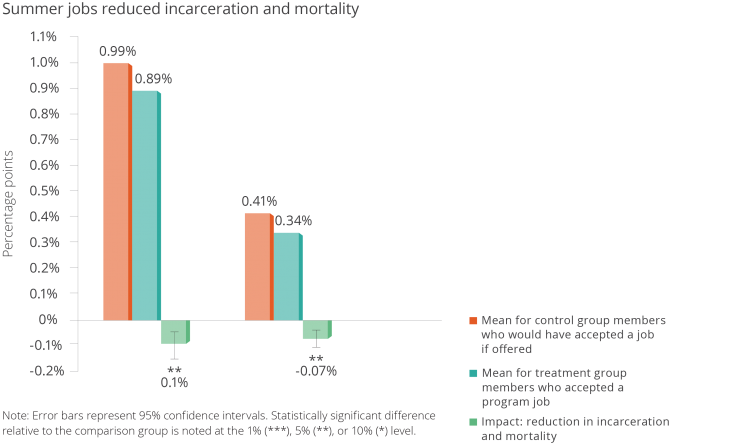The Effects of Youth Employment: Evidence from New York City Summer Youth Employment Program Lotteries
- Students
- Urban population
- Youth
- Earnings and income
- Employment
- Enrollment and attendance
- Mortality
- Sentencing and incarceration
- Recruitment and hiring
- Subsidies
- Employment
Numerous summer jobs programs in the United States seek to support the employment of young people facing barriers to employment and opportunity. Researchers studied the impact of the New York City Summer Youth Employment Program (which used a lottery to determine participation) on youth earnings, employment, college enrollment, incarceration, and mortality. Although the program increased earnings and employment during the year of participation, it caused a modest decrease in earnings in subsequent years and had no effect on college enrollment. The program also decreased the incarceration and mortality rates of program participants.
Problema de política pública
In the United States, numerous government policies and programs—from federal tax credits to municipal summer jobs programs—support the employment of young people facing barriers to employment and opportunity. These programs have multiple goals, including providing supplemental income to low-income youth, providing work experience that will improve future employment prospects, and reducing criminal or other dangerous activity. However, there is little research on whether summer jobs programs successfully achieve these outcomes, and previous studies of youth employment programs have often found program costs to outweigh benefits.
Contexto de la evaluación
Researchers studied participants in the New York City Summer Youth Employment Program (SYEP) from 2005 to 2008. At the time, SYEP was the largest summer youth employment program in the United States, providing summer jobs to, on average, more than 34,000 youths at a cost of approximately $59 million each year. SYEP placed participants in entry-level jobs and paid them the minimum wage for working up to 25 hours per week for up to seven weeks. To be eligible for the program, youth had to be between 14 and 21 years old and meet work eligibility requirements. The city contracted community-based organizations to match participants with employers and provide approximately 17.5 hours of workshops to participants on job readiness, career exploration, financial literacy, and opportunities to continue their education. The community-based organizations placed nearly half of the participants at summer camps and day care centers. Participants were also placed with various government entities and other private sector firms.
In January 2005, the first year of the study, the seasonally adjusted unemployment rate in New York City was 6 percent. The unemployment rate fell slightly until January 2008 and then rose sharply during the Great Recession, reaching a high of 10.5 percent in January 2010 before slowly declining again, largely consistent with national trends.

Detalles de la intervención
Researchers studied the impact of SYEP on the earnings, employment, college enrollment, incarceration, and mortality of the participating youth. The program received more applications than jobs available, so participation was determined by lottery. Over the study period, 294,100 qualifying applications for SYEP were received, out of which 164,641 were selected for the program and 129,459 were not selected.
The city ran a lottery to determine who would be offered a job sponsored by the program. After the initial lotteries, subsequent lotteries were conducted to fill the slots of initial winners who did not participate until all slots were filled. Applicants could re-apply in subsequent years, regardless of whether they had previously participated in the program.
The researchers linked several administrative datasets, including program application records, Internal Revenue Service data, cause of death data, and incarceration data, to track the applicants' outcomes.
Resultados y lecciones de la política pública
SYEP increased earnings during the year of the program and led to a meaningful reduction in participant incarceration and mortality. The program modestly reduced near-term subsequent earnings and had little impact on subsequent employment or college enrollment.

Earnings and Employment: Participants earned an average of $1,085 through SYEP. Participating in the summer jobs program reduced income from other sources by an average of $209 during the year of the program, meaning that participants earned an average of $876 more during that year.
SYEP participation lowered earnings of participants by approximately $100 per year for the three years after participating in the program. This effect was concentrated among participants placed in day care centers, summer camps, or similar jobs, and participants who may have had higher than average employment prospects, such as older participants and participants employed the year prior to SYEP participation. This suggests that SYEP participation may have displaced employment in jobs that could have led to higher subsequent earnings in the short run. SYEP did not significantly impact earnings subsequent to three years following participation.
During the year of participation, the program increased the probability of having a job by 71 percentage points but had minimal impact on employment thereafter. SYEP had no significant impact on college attendance.
Incarceration and Mortality: SYEP participation significantly decreased the probability of incarceration and mortality. Participants were 0.10 percentage points less likely to be incarcerated, a 10 percent reduction from the baseline incarceration rate of 0.99 percent, implying 112 fewer incarcerations. There was a decline in mortality of 0.073 percentage points, a 18 percent reduction from a baseline of 0.41 percent, equating to 83 fewer deaths. A decline in the incarceration and mortality rates of males accounted for the bulk of these declines. Researchers suggest that the reduction in deaths may be substantially attributable to a decline in death from homicide. The high cost of preventable death and incarceration suggest that a reduction in these outcomes may substantially affect cost-benefit assessments of summer youth employment programs.


